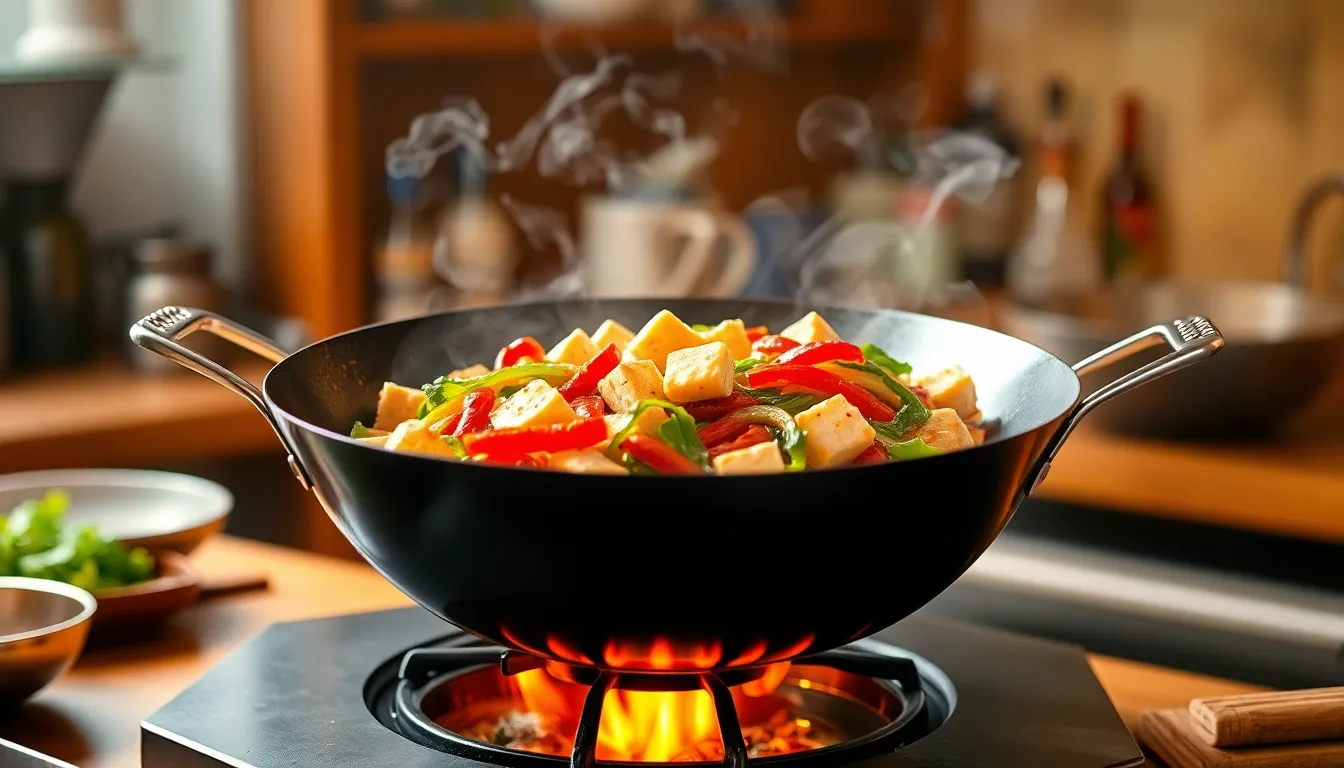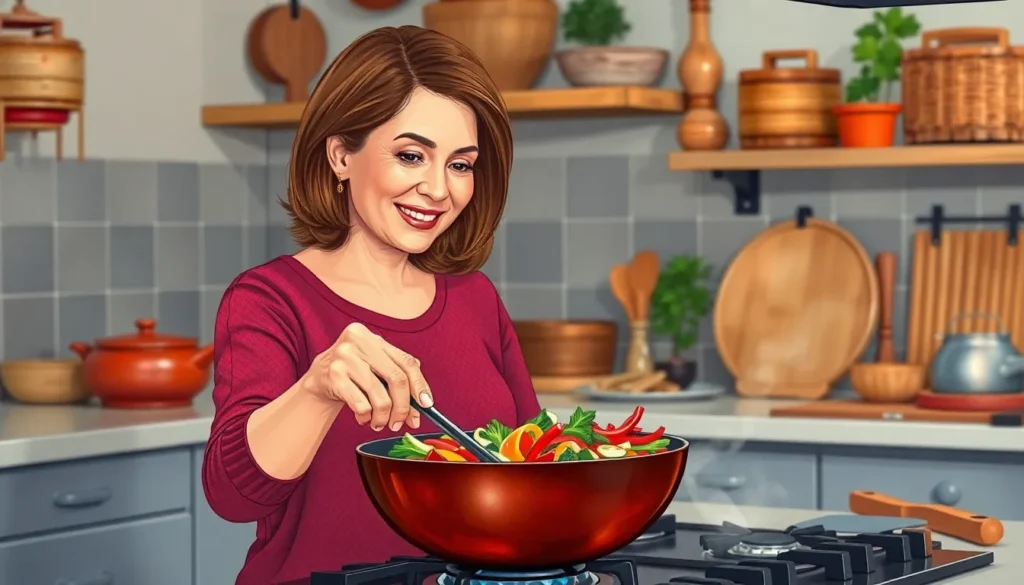When it comes to culinary artistry, Chinese cooking techniques stand out like a dragon in a sea of dumplings. From the sizzling stir-fries that make taste buds dance to the delicate art of steaming that brings out the pure essence of ingredients, these methods are as diverse as the country’s rich culture. It’s not just about throwing ingredients in a wok; it’s a symphony of flavors and textures that can turn any meal into an unforgettable experience.
Table of Contents
ToggleOverview Of Chinese Cooking Techniques
Chinese cooking techniques encompass a variety of methods that enhance flavor and texture while showcasing culinary artistry. Stir-frying stands out as a popular technique. This method cooks small, uniform pieces of food quickly in a hot wok, allowing flavors to meld without losing freshness.
Steaming also plays a crucial role in Chinese cuisine. It preserves nutrients and maintains the natural taste of ingredients, making it a preferred choice for delicate proteins and vegetables. Ingredients often retain vibrant colors and textures, resulting in visually appealing dishes.
Another notable technique is braising. This method involves slow-cooking food in a small amount of liquid, which develops deep flavors over time. Meats, such as pork and chicken, benefit significantly from braising, becoming tender and infused with spices.
Roasting adds a different dimension to Chinese cooking. It creates a crispy exterior while sealing moisture inside, exemplified by dishes like Peking duck. This technique highlights the contrast between textures, essential in culinary presentations.
Poaching serves as a gentle cooking method, showcasing the simplicity of ingredients. Foods cook slowly in flavorful liquids, resulting in succulent dishes that retain their natural essence.
Lastly, fermentation introduces additional depth to flavors. It’s not unusual for sauces and condiments to undergo fermentation, creating complexity in taste profiles.
These techniques collectively contribute to the richness and diversity of Chinese cuisine. Each method highlights the cultural significance and culinary traditions passed down through generations.
Essential Techniques In Chinese Cooking


Chinese cooking showcases essential techniques that elevate its dishes. Each method serves a purpose, enhancing flavors and textures while reflecting the cuisine’s rich culture.
Stir-Frying
Stir-frying involves quickly cooking small, uniform pieces of food over high heat in a wok. This method allows flavors to meld while preserving freshness and crunch. Using little oil, it highlights ingredients’ natural tastes and colors. Common ingredients include vegetables, meats, and tofu. Precise timing is crucial to ensure food remains tender yet crisp. This technique, rooted in Chinese culinary tradition, not only delivers fast cooking but also promotes a wholesome approach.
Steaming
Steaming preserves the nutrients and natural flavors of ingredients. This technique involves cooking food over boiling water, allowing it to become tender without added fat. Common items include fish, dumplings, and various vegetables. Using bamboo steamers maintains food’s integrity and unique textures. With this method, delicate proteins achieve succulence, while leafy greens retain vibrant colors. It represents a healthier cooking option in Chinese cuisine.
Braising
Braising combines slow cooking with flavor infusion. Typically, tougher cuts of meat benefit from this method, turning them tender while allowing spices and seasonings to permeate. Using a small amount of liquid, the dish simmers gently for several hours. Ingredients like soy sauce, ginger, and garlic create deep, rich flavors. Chinese braised dishes, such as red-cooked pork, showcase complexity and satisfaction. Complete meals often emerge from this technique, highlighting Chinese culinary heritage.
Tools And Equipment For Chinese Cooking
Essential tools and equipment enhance techniques in Chinese cooking, making meal preparation efficient and enjoyable.
Wok
The wok serves as a cornerstone in Chinese cooking. This versatile pan excels in stir-frying, steaming, and braising, thanks to its deep, curved sides. A well-seasoned cast iron or carbon steel wok distributes heat evenly, allowing quick cooking at high temperatures. Its design accommodates various cooking styles, making it perfect for everything from preparation of fried rice to sautéing vegetables. Many chefs appreciate using a wok because it retains heat, which enhances flavors and reduces cooking times.
Steamer
Steamers play a vital role in maintaining healthy cooking practices. Bamboo steamers rank as the traditional choice, offering an authentic method to prepare dumplings and vegetables. Steaming preserves the nutrients found in food while keeping flavors intact. The tiered design allows for multiple dishes to cook simultaneously, maximizing efficiency. Stainless steel steamers represent a durable alternative, providing easy handling and cleanup. Many culinary enthusiasts recognize steaming as a key technique in Chinese cuisine, often realizing it promotes freshness and tenderness in dishes.
Cleaver
The cleaver remains indispensable in Chinese kitchens. Known for its wide, heavy blade, it excels at chopping, mincing, and slicing ingredients with ease. Chefs appreciate its versatility, using it for tasks ranging from cutting vegetables to portioning meats. A good cleaver balances weight and sharpness, allowing for precise control during food preparation. Many cooks find that using a cleaver enhances their efficiency, making it easier to achieve uniform pieces essential for even cooking. Its iconic design and practicality make the cleaver a staple tool across various Chinese cooking techniques.
Regional Variations In Chinese Cooking Techniques
Chinese cuisine showcases diverse regional cooking techniques, each offering unique flavors and methods. The following sections explore notable variations.
Cantonese Techniques
Cantonese cooking emphasizes freshness and flavor, often using techniques that enhance the natural ingredients. Steaming is prevalent, preserving the delicate taste and nutritional value of seafood and vegetables. For instance, dim sum showcases a variety of small, steamed dishes enjoyed in social settings. Stir-frying also plays a significant role, allowing quick preparation while retaining the vibrant colors and textures of ingredients. Fresh herbs and mild seasonings highlight the natural flavors, reflecting the Cantonese dedication to culinary balance. Roasting, particularly seen in dishes like Cantonese roast duck, creates a crispy skin and succulent meat, demonstrating mastery in heat control.
Sichuan Techniques
Sichuan cuisine stands out for its bold flavors and distinctive cooking methods. Stir-frying is common but often incorporates ample amounts of garlic and ginger for depth. These ingredients create dishes that burst with flavor, like mapo tofu. Another signature method includes braising, which allows spices to infuse richly into the ingredients over time. The use of chili oil and Sichuan peppercorns adds heat and numbing sensations, elevating dishes like Kung Pao chicken. Techniques such as pickling and fermentation enhance flavors further, contributing to the complex profiles typical of Sichuan cooking. Together, these methods reflect the region’s renowned culinary identity.





